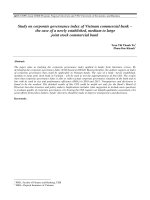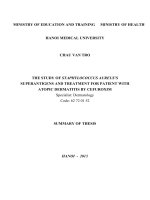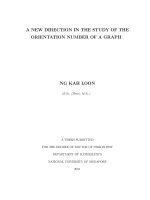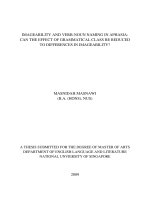Semantics Semantics is the study of meaning that is used to understand human expression through language.
Bạn đang xem bản rút gọn của tài liệu. Xem và tải ngay bản đầy đủ của tài liệu tại đây (3.35 MB, 26 trang )
SEMANTICS
Hua Thi Hoai Thu (Autumn)
MA student
LSPU, Siniloan Campus
What is “semantics”?
Semantics is the study of meaning that is used to understand human
expression through language.
Semantics is perhaps the most difficult part of the grammar of a
language to learn.
Language is arbitrary. It is arbitrary because the relationship between
forms and their meanings are sometimes can not logically proved.
Although a form can have more than one meaning, there is always a primary or
original meaning that is express.
The original meaning of a form in a language is normally called “denotation”.
With respect to words (lexical terms), the primary (original) meaning is the
meaning that we can find in a dictionary
E.g.
Rose
Rose
The flower of a rose brush
The flower of a rose brush
What is “semantics”?
Beside, there are additional meaning, which is know as “connotation”.
With respect to words, connotation or additional meanings of a word are
not listed in a dictionary; and therefore we can not find them in a
dictionary.
Normally, a person expresses a connotative meaning through a word,
phrase, clause or sentence based on certain characteristics of the entity or
event that he/she is referring to.
E.g.
One may call a beautiful girl
a “rose” or a “lily”
One may call a beautiful girl
a “rose” or a “lily”
What is “semantics”?
Conceptual meaning refers to the linguist function of the word, that provides its
meaning.
E.g. Money
Money: It’s an object (or series of them) that allow people to buy
goods
Associative meaning deals with the concepts that we add to the original word
E.g. Money
Money: Rich, job, to work, tired, coin, poor, etc.
Conceptual and
associative meaning
The Semantic Features are ‘categories’ that allow us to classify the meaning of
a word
They are usually represented with a headword and using the symbols ‘+’ and
‘-’ to say if the word contains that feature.
There is no list of semantic features. We need the context to create one.
Semantic features
Click to edit Master text styles
Second level
Third level
Fourth level
Fifth level
Man
Woman
Girl
Table
Horse
Boy
Semantic features
The semantic roles are properties that the noun phrases have
according to their meaning inside the sentence
The semantic roles are:
Agent
Theme
Instrument
Experiencer
Location
Source
Goal
Semantic roles
The boy kicked a ball
In that sentence, the person who executes the action is called AGENT. The agent
in that sentence is the boy
The THEME is the object or person that is directly affected or described by the
action. In this case a ball
Agent & theme
The boy cut his hair with the scissors
In this example, we can notice that there is a tool that helps the Agent to
perform the action. That is the semantic role of INSTRUMENT
He felt sad about cutting his hair
When the action is related to a feeling, a state or perception, the agent takes
the name of EXPERIENCER
Instrument &
experiencer
The keys are next to the vase.
She brought some souvenirs from France.
Marco travels to Merida tomorrow.
In the first sentence the text in blue marks the semantic role of Location
In the second, the semantic role of Source
In the third one, the semantic role of Goal
Location, source and
goal
Not just the semantic roles provide a meaning to the
words, phrases or sentences. Sometimes meaning comes
from the semantic relationships that are built.
Synonymy
Antonymy
Hyponymy
Prototypes
Homophones and
Homonyms
Polysemy
Word-play
Metonymy
Lexical relations
POLYSEMY
Polysemy is the state or phenomenon in which the words that have more
than one meaning. In other words, it can be described as multiple
meanings of words. The words are considered to be related etymologically.
The concrete form of polysemy is called “polysemy”.
E.g.
Plain
Plain
Simple (e.g. English is extremely plain subject).
With nothing added/ not decorate in anyway (e.g. This blouse is too plain).
Simple (e.g. English is extremely plain subject).
With nothing added/ not decorate in anyway (e.g. This blouse is too plain).
SYNONYMY
Synonymy is the state or phenomenon in which the words that sound different
(different in pronunciation) but have the same or identical meaning as another
word or phrase.
The concrete form of synonymy is called synonym.
E.g.
Small = Little
Big = large
Mother and father = parents
Politician = Statesman
ANTONYMY
Antonymy is the state or phenomenon in which the words have the sense
relation which involve the opposite of meaning.
The concrete form of antonymy is called “antonym” (opposite).
The word pairs of antonym can be divided into several types:
•
Implicitly gradable pairs (graded antonym)
•
Complementary pairs (complementarity)
•
Relational pairs (converseness)
a. Implicitly gradable
pairs
Graded antonym refers to the words related to the object they modify. The
words themselves do not provide an absolute scale.
E.g.
Big >< small Good >< bad
Fast >< slow Young >< old
Thus, when we say that “a fly is bigger than another” we imply that “big”
is to be understood in the context of “flies”.
Another fact dealing with this type is that “a small elephant” for
example, is much bigger than “a big mouse”.
a
. Implicitly gradable
pairs
Another characteristic of certain pairs of gradable antonyms is that one is
marked and the other is unmarked.
The unmarked member is the one used in questions of degree.
We ask: ordinarily, “how high is the mountain?” (NOT “How low is it?”)
We answer, “ten thousand feet high”, but never “ten thousand feet low”,
EXCEPT humorously or ironically or the topic of the conversation is the
conversation is the particular context.
Thus, “high” is the unmarked member of “high/low”
b. Complementary pairs
Complemetarity refers to the existence of pairs that the denial of one,
implies the assertion of the other.
E.g.
Male >< female
Alive >< dead
Present >< absent
awake >< asleep
Thus, if one is not male, then one is certainly female, if one is not
present, the he/she must be absent, and so on…
Incomparable objects
Incomparable objects
Related to complementary pairs, sets of terms like colors or numbers where the
assertion of one member implies the negation of all the others.
Thus, if we have a set of such as:
√ X X X X
When we say: “this is green”, for instance, it means that it is not yellow,
brown, red or blue.
green yellow
Brown
red
blue
b. Complementary pairs
c. Relational pairs
Converseness refers to the pair of words that display symmetry in their
meaning.
If X give Y to Z, then Z receives Y from X
Relationships between certain semantic features can reveal knowledge
about antonym.
Other commonly relational pairs are:
buy >< sell
push >< pull
give >< take
teach >< learn
doctor >< patient
In the context of sentence, occasionally the same verb can be supposed as a
relational pair.
E.g.
John married Mary >< Mary married John
c. Relational pairs
HYPONYMY
Hyponymy is the state or phenomenon that show the relationship between
more general term (lexical representation) and the more specific instances of
it.
The concrete forms of sets of word (the specific instances) are called
“hyponymy”.
E.g.
The lexical presentation of:
Red, yellow, green, blue, black is [+color]
Thus we can say that: “red” is a hyponym of “color” and so on …
Sometimes there is no single word in the language that encompasses
as set of hyponyms.
E.g.
Clarinet, guitar, piano, trumpet, violin are hyponyms because they are
“musical instruments”, but there is not a single word meaning “musical
instrument” that has these words as its hyponyms.
HYPONYMY
The relationship between the general term and the specific
instances is often be described using a hierarchical diagram, called
“taxonymy”.
HYPONYMY
Summary
Semantics is the study of meaning.
Polysemy is the capacity for a sign or signs to have multiple related meanings.
Synonymy is a word with the same or similar meaning of another word.
Antonym is one of a pair of words with opposite meanings.
Hyponym is a word or phrase whose semantic field is included within that of
another word.









